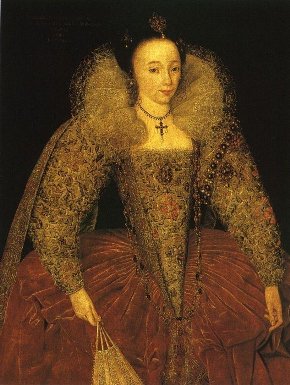
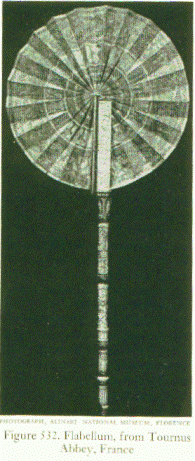
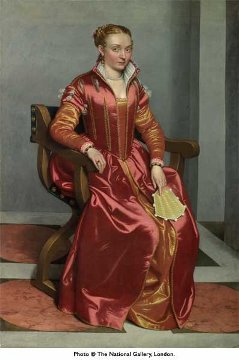
3 - anno 1555
THE FAN THROUGH THE CENTURIES
 |
 |
 |
| 1 - anno 1595 | 2 - anno 875 ca. |
3 - anno 1555 |
The fan is very ancient: its use began in the night of all times, when people, to move air and send away the bugs, unconsciously shook the hand.
The evolution of this precious object was determined by commercial and cultural exchanges between Orient and Occident. The finding of many Egyptian finds documents the daily use of the fan since 3200 b.C.: it was rigid, not folding; those with long handle belonged to important dignitaries and were used to refresh or protect the Pharaon from the insects; they were also used by the priests to purify the divine statues.
Two fans which are exposed at The Cairo's Museum, originally with forty-two alternated white and brown ostrich feathers, belonged to Tutankhamon: their handles are of ivory, gold and precious stones.
Some archaeological testimonies, such as Grecian and Roman vases and statues, document the use of leaf shaped screens, which could be realized with vegetables or feathers.
From Etruscan period we have the bronze flabella of Populonia with relief decorations, dating from the second half of the VII century b.C., considered a masculine and a female status symbol.
The flabellum use was adopted also by the Christian Church for its liturgy.
Big flabella were used till the pontificate of Giovanni XXIII ( 1963 ).
Italy has three very precious flabella which demonstrate their use till the late Middle Age. The most ancient is in the St. John's Basilica treasure of Monza: it's a cockade fan, with case, of about 600 A.D., probably belonged to the Queen Theodolinda.
The second, (875 A.D. ca.), coming from the Tournus Abbey,is at Florentine Bargello Museum. Also this exemplar is a cockade fan (round at 360°), of hand-painted vellum with saints and vegetable decorations and it has an ivory and bone case-handle, wonderfully carved. The last one is in Puglia and dates from XIII century.
In the XIII century a new shape for fans appeared, called “flag fan”. Diffused in Europe till the appearance of the folding fans in 1500, it's still in use near some peoples. Before the half of 1500 the screens were used to give relief to the sufferings in the hospitals, to the givingbirths, or in the inns and at the barber's shop: the hygienic rules were not respected, so the annoying bugs proliferate.
During the XVI century the folding fan was born, consisting of sticks and folding leaf. These new exemplars, extremely more comfortable, so that they are still in use, arrived in Europe from the Orient, thanks to the Portuguese and Venitian commercial relations. They were probably invented in Japan and in China in the IX century, drawing inspiration from the bat wing's conformation.
The success of these fans was enormous: we have to thank, for their diffusion,Caterina de'Medici (1519/1589), who took a big number of them in her corbeille de marriage to the French Court, where they aroused wonder.
In 1500 the fan leaves were done of cabretille or swan skin, and pierced to imitate the Italian lace, called “reticella”.
An other Queen left a big number of fans with gold and precious stones handles, being she passioned: Elisabeth I (1533/1603).
In Japan the fan was used by men: during the war and the battles. The commanders gave their orders with this, and sometimes it turned itself into a weapon, because the sticks were of iron or steel.
Also in Occident, till the whole XIX century, men used the fan.
The excessive luxury that sometimes these objects reached, induced the Venitian Republic Senate to emanate laws against the use of too much precious materials.
In 1600 the fan attracted many famous artists,such as Carracci and Bosse: they left many drawings and etchings. During this century were born a few corporations of artist and artisans, under the patronage of King Sun in France, and Queen Anne Stuart in England.
During XVIII century also the porcelain miniaturists painted fan leaves; the fan become an essential object for the court etiquette. During this period,infact,the noble and high middle class dames owned many exemplars to be used in all daily occasions, independently from the climate; the fans articulated the life of the reachest ladies: for the engagement, in the corbeille de marriage, for the presentation at court, to celebrate a birth, for a mournful event.
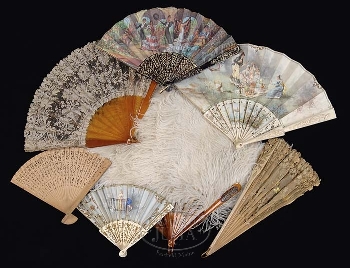 |
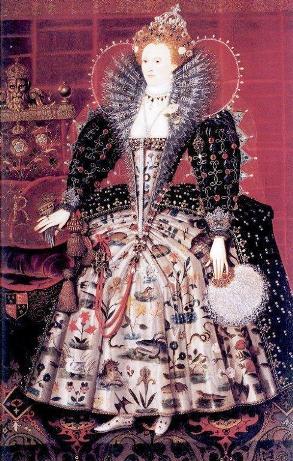 |
| 4 - miscellaneus XIX - XX Century | 5 - Elisabetta I |
In this century there were also religious fans, to be used inside churches, or to divulge dances on fashion, with the plant of the theatres and the names of the stages owners, as carnets de bal, or as geographical maps.
Also some rare exemplars of doll's and child fans have arrived to us, some of them in precious materials.As for the mothers, the etiquette also imposed the use of this accessory, often of identical shape,to the daughters and consequently to theirs dolls.
At the time of French Revolution fans were a way to divulge to the people some important events and the story of great personages. Some of these fans were against revolution, and so absolutely forbidden, because they hymned to Louis XVI and to the Royal Family: they are very rare.
According to the fashion dimension and shape of fans change. The leaf was often hand-painted on leather, treated to become very thin, called “swan skin”.
Unlike Europeans, Chineses painted their leaves only on paper and silk. They were exceptional ivory, tortoise shell,mother of pearl carvers, eccellent lacquerers and very skilled enamellers and filigree workers. A very common type of Chinese fan was the “One thousand faces”: on the leaf we see court and life scenes, with personages having small faces of hand-painted ivory, and dressed with cloths of cut and applied silk.
Italy, after dictating law about fans for all XV and XVI century, and after having been outclassed by France and England, better organized and competitive, imposed again its own style in XVIII century with exemplars produced in Milan,Venice,Florence,Rome and Neaples. The most appreciated, immediatly recognizables,were the ones with urban, archaeological and landscape sights, called “Grand Tours”. They were bought as a souvenir of the travels done by the nobles through South Europe, with obliged stop in Italy. The during of these culture and instruction moves varied between two and five years.
In 1700's also a “distance” language was born, to transmit particular messages according to the way to hold,open and show the fan. It was encoded in XIX century and it was very useful for the ladies to establish secret meetings, but also for society plays.
After the habit to make fans to preserve travel or historical and political events memory, or to commemorate Universal Exhibitions, advertising fans began to be realized.
Today fans are often made with poor materials, because they don't make part of women wardrobe from a long time: the speed of modern life imposes a necessary adaptation of the attire.
In the last time,however, we realize that the fan is beginning a new life thanks to the collecting rebirth and the interest of important contemporary artists to this precious object.
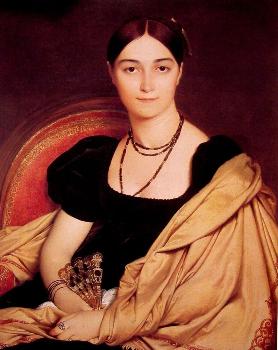 |
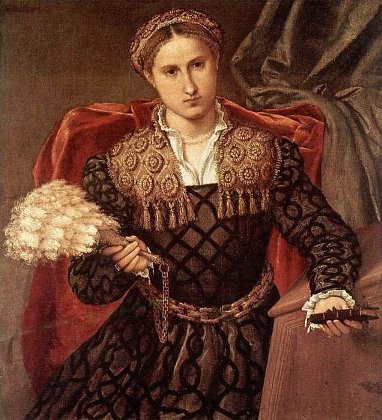 |
| 6 - anno 1807 | 7 - anno 1554 |